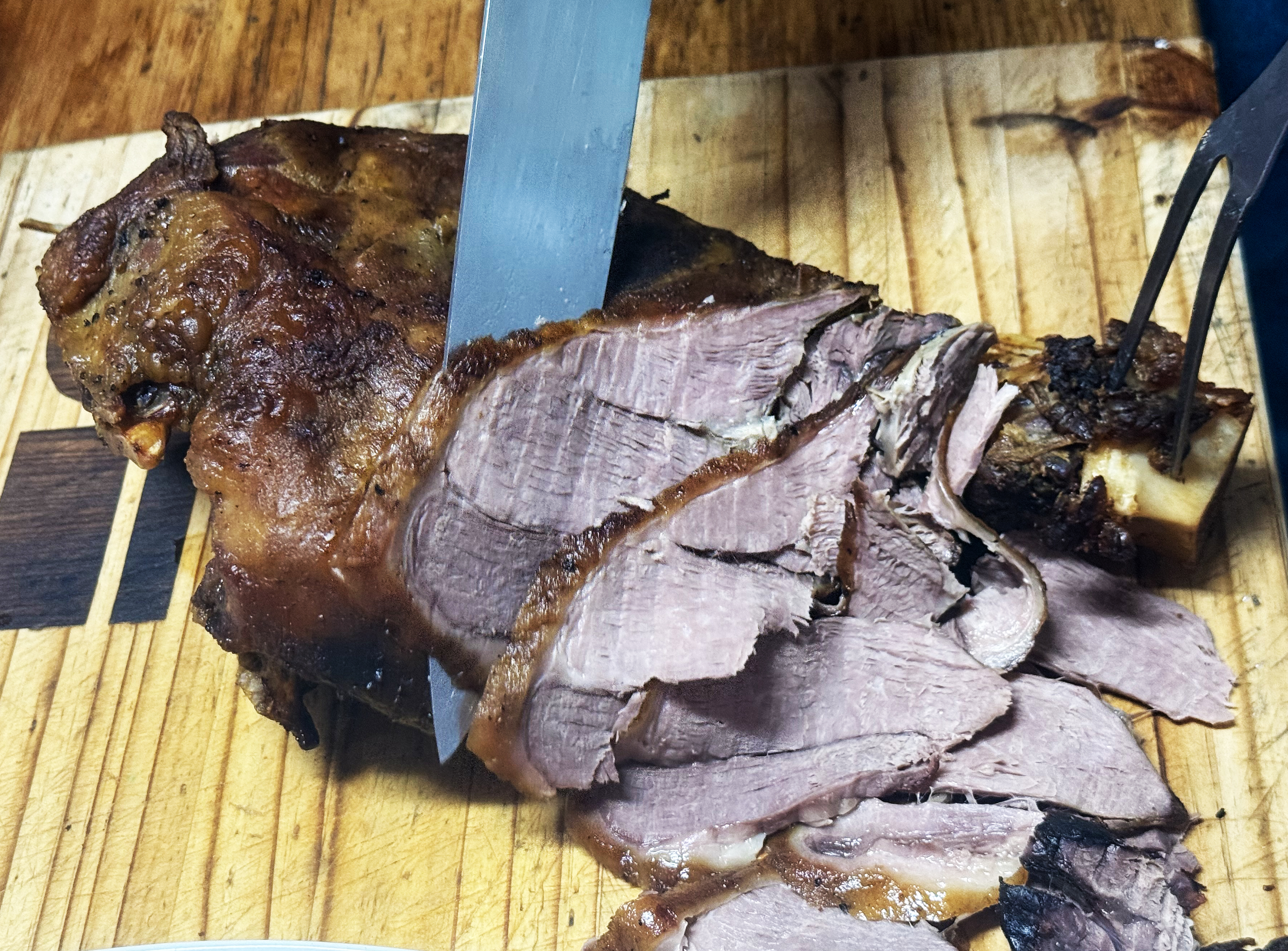Kapokbos. A lovely word, as so many Afrikaans words are, for those with an ear for music in language. Aka wild rosemary, or wilderoosmaryn. Scientifically known as Eriocephalus africanus. But I’ll take kapokbos — and use it in a recipe too.
“Kapok” refers to drifting, lightweight snowflakes that disappear before they can settle on the ground. In Sutherland in the icy Northern Cape the people say “the kapok is coming” when the clear sky suddenly turns dark and the wind gains a certain urgency that locals can feel in their bones. I’ve felt the kapok in my bones.
Kapokbos is one of the wild Karoo herbs that sheep munch on Karoo farms far and wide. We’ve had April rains in Cradock, something to be celebrated, and the veld is green, the low-slung shrubs lush with new leaves. I drove out of town and picked a few sprigs of kapokbos. Then I came home and saw the butter.
This joint of mutton — a whole leg, which I didn’t weigh but surely was well above 3kg, maybe even 4kg — was going to need time, and lots of it. No quest for rare, pink-in-the-middle lamb here. This lamb had grown to sturdy adulthood and deserved to be treated with respect accordingly.
I melted a load of butter and then added some more. Let’s say it was about half a cup. Maybe more. Probably more, knowing me.
The sprigs of kapokbos went in the melted butter on a very low heat, then I turned the heat off so that they could steep in the hot butter. The aroma wafted past, gaining herbaceous intensity. Then I lifted the sprigs out and kept them to one side.
This was last Sunday, and quite early in the day. I seared the leg in a little of the kapokbos butter on all sides, having preheated the oven, then put the sprigs back in the pan, covered it and shoved it in the oven.
It spent the rest of the day cooking at the lowest heat possible, and turned out succulent and so, so soft at the end of the day.
And there was wine…
A bottle of Jean Engelbrecht’s Guardian Peak Cabernet Sauvignon, vintage 2022, that had been given to me for my birthday was recommended for “grilled and roast beef, mushroom risotto and lamb”. Mutton too, surely, I decided. Powerful, ripe raspberry, blackcurrant and soft milk chocolate, the label promised.
Didn’t quite find that last one. Maybe it attached itself to a snowflake and drifted away. But bold, yes, with tannins just tamed, like a horse bursting to get out of the gate.
Yep, this would do very well. The wine waited patiently for the mutton to be cooked.
Tony’s all-day leg of mutton with kapokbos butter
 Carving the leg of mutton cooked in kapokbos (wild rosemary) butter. (Photo: Tony Jackman)
Carving the leg of mutton cooked in kapokbos (wild rosemary) butter. (Photo: Tony Jackman)
(Serves 8-12)
Ingredients
1 x leg of mutton, 3kg to 3.5kg
½ a cup of butter
4 long sprigs of kapokbos (wild rosemary) or 8 sprigs of garden rosemary
Salt to taste
Black pepper to taste
Method
Preheat the oven to 180°C.
Make sure the mutton leg is completely thawed, if it has been frozen, and at room temperature right to the bone.
Season it all over with salt and black pepper.
Melt the butter in a roasting pan (that has a lid) on a medium heat. Add the kapokbos sprigs and turn off the heat. Leave it to steep for 5 to 10 minutes — if the butter starts to solidify, give it a bit more heat and turn it off again.
Remove the sprigs and retain them. Pour off much of the butter to be added again later.
Turn the heat to medium and, when the butter starts foaming a little, add the joint and brown it on all sides. Pour the remainder of the kapokbos butter over the meat and add the sprigs back, some on the meat, others in the butter.
Put the lid on the roasting pan and put it in the oven.
Let it roast at 180°C for 20 minutes, then turn the heat down very low, maximum 160°C.
Leave it to cook all day, about 8 to 10 hours.
There will be plenty of liquid which is a sauce in its own right. Pour the liquid off into a saucepan and reduce it (by two-thirds or by half) on a high heat to embolden the flavour. For a thicker sauce, stir in 1 Tbsp of cornflour dissolved in a half ramekin of cold water. Taste, and adjust seasoning if you wish to.
Serve with classic sides for a meaty roast, such as creamed spinach, glazed carrots, cauliflower cheese, and roast potatoes. Cheers to this good life. DM
Tony Jackman is twice winner of the Galliova Food Writer of the year award, in 2021 and 2023
Order Tony’s book, foodSTUFF, here.
Follow Tony Jackman on Instagram @tony_jackman_cooks.




 Carving the leg of mutton cooked in kapokbos (wild rosemary) butter. (Photo: Tony Jackman)
Carving the leg of mutton cooked in kapokbos (wild rosemary) butter. (Photo: Tony Jackman)
